Seabirds to Spot While Paddling Coastal Maine
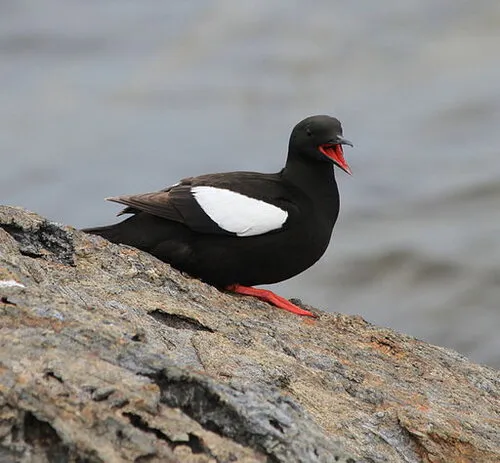
When you’re kayaking on the coast of Maine, you’ll be sharing the water not just with fellow paddlers, but a menagerie of wildlife, especially seabirds.
Seabirds are birds that are adapted to marine environments, and spend much of their life foraging or breeding at sea.
To help you get better acquainted with some of the seabirds you might see while you’re out on the water, here’s a roundup of some of coastal Maine’s iconic seafaring feathered-friends.
Common Eider

Common eiders are big ducks – the biggest duck species in North America, in fact. Females are reddish-brown in color, but with their black and white plumage, males are much easy to spot; just look for a white back, dark sides, black cap, and pale green on the sides of their necks. Males and females are often spotted swimming together in flocks. When females are raising young, they’ll gather the babies together so they can feed safely, like eider play-dates. Eiders love shellfish and will swallow them whole, crushing the shells in their stomachs. These seabirds are quite vocal and often sound rather comical, like hungry diners presented with a gluttonous dessert.
You can find out more about Common Eiders from the Cornell Lab of Ornithology here and listen to male and female calls and chick sounds here.
Cormorant
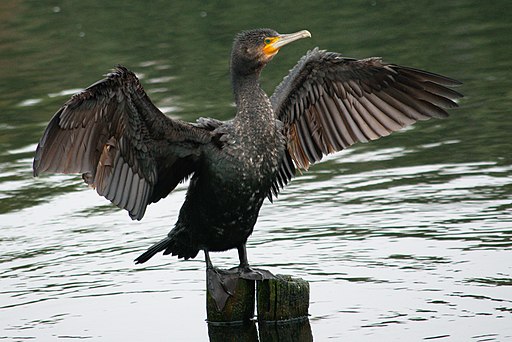
If you spot a dark-feathered bird with a long neck standing in the breeze, perhaps on a piling or at the rocky shoreline, with its wings outstretched – chances are it’s a cormorant drying out its non-water repellant feathers. Both great cormorants and double-crested cormorants can be seen in Maine. In the summer, double-crested cormorants (which have orange-yellow skin around the base of their bills and a darker face and thinner bill and neck) are common in Casco Bay. And while it’s hard to see from a kayak, the inside of their mouth is bright blue. Unlike ducks, which tend to float around and hang out on the water, when cormorants are on the water, they are typically fishing – diving deep under water for up to one to two minutes at a time.
Find out more about cormorants from the Cornell Lab of Ornithology here and listen to their calls here.
Osprey
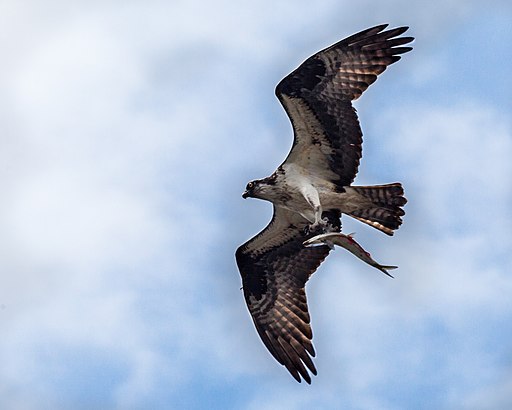 Also called “sea hawks” or “fish hawks” on account of all the fish they eat, osprey are impressive hunters, dive-bombing for fish feet first and capturing them in their talons. When flying with a fish in their talons, osprey will carry it pointing head-first to be more aerodynamic. Their huge nests (often over six feet wide) are easy to spot from the water – a rather slapdash pile of sticks perched atop a tree, channel marker, or utility pole. Osprey nests can be used by several generations – getting bigger with every new breeding pair. Though smaller than bald eagles, the raptors themselves are quite large, with brown wings and back and white underparts, a brown line/mask through their yellow eyes, and a dark, hooked beak. When soaring, their wings make an “M” shape, with wingtips bent downward.
Also called “sea hawks” or “fish hawks” on account of all the fish they eat, osprey are impressive hunters, dive-bombing for fish feet first and capturing them in their talons. When flying with a fish in their talons, osprey will carry it pointing head-first to be more aerodynamic. Their huge nests (often over six feet wide) are easy to spot from the water – a rather slapdash pile of sticks perched atop a tree, channel marker, or utility pole. Osprey nests can be used by several generations – getting bigger with every new breeding pair. Though smaller than bald eagles, the raptors themselves are quite large, with brown wings and back and white underparts, a brown line/mask through their yellow eyes, and a dark, hooked beak. When soaring, their wings make an “M” shape, with wingtips bent downward.
Find out more about osprey from the Cornell Lab of Ornithology here.
Gulls
Seagulls need no introduction. They’re big, noisy, smart, inquisitive, highly adaptive and opportunistic feeders that can feed on a wide range of prey (like your boardwalk fries and picnic basket). Plus, they’re comfortable in both fresh and saltwater, thanks to salt glands situated just above their eyes that pull excess salt out of their system and then excrete it out of their nostrils. While more than 30 species of gull can be found across North America, here’s the trio you’re most likely to spot in and around coastal waters in Maine.
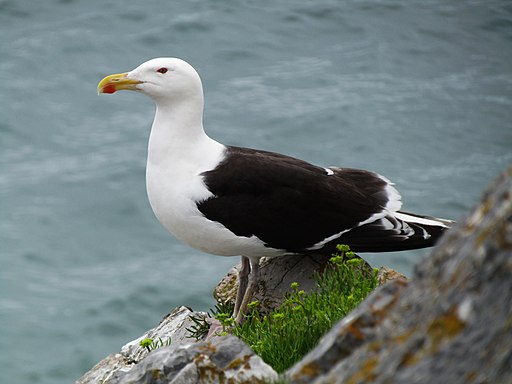 |
The Great Black-backed Gull is so named thanks to its dark, nearly black wings and back (more of a charcoal gray). The largest gull in the world (topping out at four pounds), they’re bigger than their counterparts, and are considered the “king of gulls”.
Read more about Great Black-backed Gulls here. |
 |
The Ring-billed Gull has pale gray wings and back and a black band around its bill, and is most likely to be seen inland and near freshwater as well as on the coast. This species tends to be more comfortable around humans, and frequent parking lots, dumps, beaches, fields, etc – sometimes en masse.
You can find out more about Ring-billed Gulls here. |
 |
Herring gulls also have pale gray wings and back and black wingtips, but rather than a black band around their bills, they have a red spot on their lower bills. (Many gulls have this red spot – including the great black-backed gull – but if you’re in Maine and see a gull with pale gray wings and a red spot on its bill, it’s probably a herring gull.) Though not as large as Great Black-backed Gulls, they’re on the bigger side, with hefty bodies and bills. This species is the one typically spotted on patrol – scavenging for scraps on the water or the beach, and sometimes snatching a snack or meal from a fellow gull. For more about Herring Gulls, check out this guide. |
Common Tern
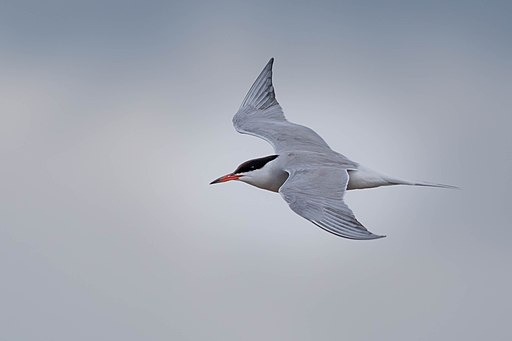 Once you start to notice the differences and variety of gulls, you might also start to notice that some of those “seagulls” are actually terns. Though members of the same family, gulls and terns are distinct from each other. The most common tern in coastal Maine is, believe it or not, the Common Tern. Unlike the white-headed Herring, Ring-billed and Great Black-backed Gulls, Common Terns have a black cap and a slender red bill with a black tip. They also tend to be smaller and more slender than their gull cousins, and have forked-tails and will dive for fish, which gulls don’t do. Like gulls, they can drink freshwater and saltwater – the Common Tern can even drink “on the wing,” flying close to the water’s surface and dipping its bill. In the late 1800s, when feathered hats were all the rage, Common Terns were captured for their feathers and the population was nearly wiped out . The North American Migratory Bird Act made possession and sale of many bird feathers illegal, and the terns eventually returned.
Once you start to notice the differences and variety of gulls, you might also start to notice that some of those “seagulls” are actually terns. Though members of the same family, gulls and terns are distinct from each other. The most common tern in coastal Maine is, believe it or not, the Common Tern. Unlike the white-headed Herring, Ring-billed and Great Black-backed Gulls, Common Terns have a black cap and a slender red bill with a black tip. They also tend to be smaller and more slender than their gull cousins, and have forked-tails and will dive for fish, which gulls don’t do. Like gulls, they can drink freshwater and saltwater – the Common Tern can even drink “on the wing,” flying close to the water’s surface and dipping its bill. In the late 1800s, when feathered hats were all the rage, Common Terns were captured for their feathers and the population was nearly wiped out . The North American Migratory Bird Act made possession and sale of many bird feathers illegal, and the terns eventually returned.
For more about Common Terns, read about the species here.
Black Guillemot

With their black bodies, white wing patches, and striking red legs, Black Guillemots (pronounced gill-uh-mott) look like they’re dressed up for a night on the town. This member of the Auk family likes to spend time on the rocky coast of the North Atlantic (think Maine and the Canadian Maritimes) especially in the spring and summer, and forages for fish and invertebrates close to shore. Great divers, they tend to sit on the water like ducks, and are able to remain underwater for two minutes or longer. Guillemots are often seen on their own, away from other species.
Learn more about Black Guillemots here.
